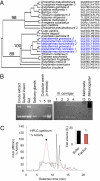Targeting an antimicrobial effector function in insect immunity as a pest control strategy
- PMID: 19506247
- PMCID: PMC2722268
- DOI: 10.1073/pnas.0904063106
Targeting an antimicrobial effector function in insect immunity as a pest control strategy
Abstract
Insect pests such as termites cause damages to crops and man-made structures estimated at over $30 billion per year, imposing a global challenge for the human economy. Here, we report a strategy for compromising insect immunity that might lead to the development of nontoxic, sustainable pest control methods. Gram-negative bacteria binding proteins (GNBPs) are critical for sensing pathogenic infection and triggering effector responses. We report that termite GNBP-2 (tGNBP-2) shows beta(1,3)-glucanase effector activity previously unknown in animal immunity and is a pleiotropic pattern recognition receptor and an antimicrobial effector protein. Termites incorporate this protein into the nest building material, where it functions as a nest-embedded sensor that cleaves and releases pathogenic components, priming termites for improved antimicrobial defense. By means of rational design, we present an inexpensive, nontoxic small molecule glycomimetic that blocks tGNBP-2, thus exposing termites in vivo to accelerated infection and death from specific and opportunistic pathogens. Such a molecule, introduced into building materials and agricultural methods, could protect valuable assets from insect pests.
Conflict of interest statement
The authors declare no conflict of interest.
Figures




Similar articles
-
Subterranean termite prophylactic secretions and external antifungal defenses.J Insect Physiol. 2011 Sep;57(9):1259-66. doi: 10.1016/j.jinsphys.2011.05.016. Epub 2011 Jun 15. J Insect Physiol. 2011. PMID: 21708164
-
Termites and Chinese agricultural system: applications and advances in integrated termite management and chemical control.Insect Sci. 2021 Feb;28(1):2-20. doi: 10.1111/1744-7917.12726. Epub 2019 Oct 15. Insect Sci. 2021. PMID: 31529680 Free PMC article. Review.
-
Molecular antifungal defenses in subterranean termites: RNA interference reveals in vivo roles of termicins and GNBPs against a naturally encountered pathogen.Dev Comp Immunol. 2012 Feb;36(2):372-7. doi: 10.1016/j.dci.2011.07.008. Epub 2011 Jul 30. Dev Comp Immunol. 2012. PMID: 21824492
-
Insect pathogens as biological control agents: Back to the future.J Invertebr Pathol. 2015 Nov;132:1-41. doi: 10.1016/j.jip.2015.07.009. Epub 2015 Jul 27. J Invertebr Pathol. 2015. PMID: 26225455 Review.
-
Termite (order Blattodea, infraorder Isoptera) baiting 20 years after commercial release.Pest Manag Sci. 2015 Jul;71(7):897-906. doi: 10.1002/ps.3913. Epub 2014 Nov 7. Pest Manag Sci. 2015. PMID: 25244627 Review.
Cited by
-
Taxonomic profiling of Nasutitermes takasagoensis microbiota to investigate the role of termites as vectors of bacteria linked to ironwood tree decline in Guam.PLoS One. 2023 Dec 22;18(12):e0296081. doi: 10.1371/journal.pone.0296081. eCollection 2023. PLoS One. 2023. PMID: 38134025 Free PMC article.
-
Mode of Infection of Metarhizium spp. Fungus and Their Potential as Biological Control Agents.J Fungi (Basel). 2017 Jun 7;3(2):30. doi: 10.3390/jof3020030. J Fungi (Basel). 2017. PMID: 29371548 Free PMC article. Review.
-
Molecular signatures of nicotinoid-pathogen synergy in the termite gut.PLoS One. 2015 Apr 2;10(4):e0123391. doi: 10.1371/journal.pone.0123391. eCollection 2015. PLoS One. 2015. PMID: 25837376 Free PMC article.
-
A life-and-death struggle: interaction of insects with entomopathogenic fungi across various infection stages.Front Immunol. 2024 Jan 8;14:1329843. doi: 10.3389/fimmu.2023.1329843. eCollection 2023. Front Immunol. 2024. PMID: 38259477 Free PMC article. Review.
-
Combining proteomics and transcriptome sequencing to identify active plant-cell-wall-degrading enzymes in a leaf beetle.BMC Genomics. 2012 Nov 1;13:587. doi: 10.1186/1471-2164-13-587. BMC Genomics. 2012. PMID: 23116131 Free PMC article.
References
-
- Bischoff V, et al. Function of the drosophila pattern-recognition receptor PGRP-SD in the detection of Gram-positive bacteria. Nat Immunol. 2004;5:1175–1180. - PubMed
-
- Janeway CA, Jr, Medzhitov R. Innate immune recognition. Annu Rev Immunol. 2002;20:197–216. - PubMed
-
- Lemaitre B, Nicolas E, Michaut L, Reichhart JM, Hoffmann JA. The dorsoventral regulatory gene cassette spatzle/Toll/cactus controls the potent antifungal response in Drosophila adults. Cell. 1996;86:973–983. - PubMed
-
- Watson FL, et al. Extensive diversity of Ig-superfamily proteins in the immune system of insects. Science. 2005;309:1874–1878. - PubMed
Publication types
MeSH terms
Substances
Grants and funding
LinkOut - more resources
Full Text Sources
Other Literature Sources

